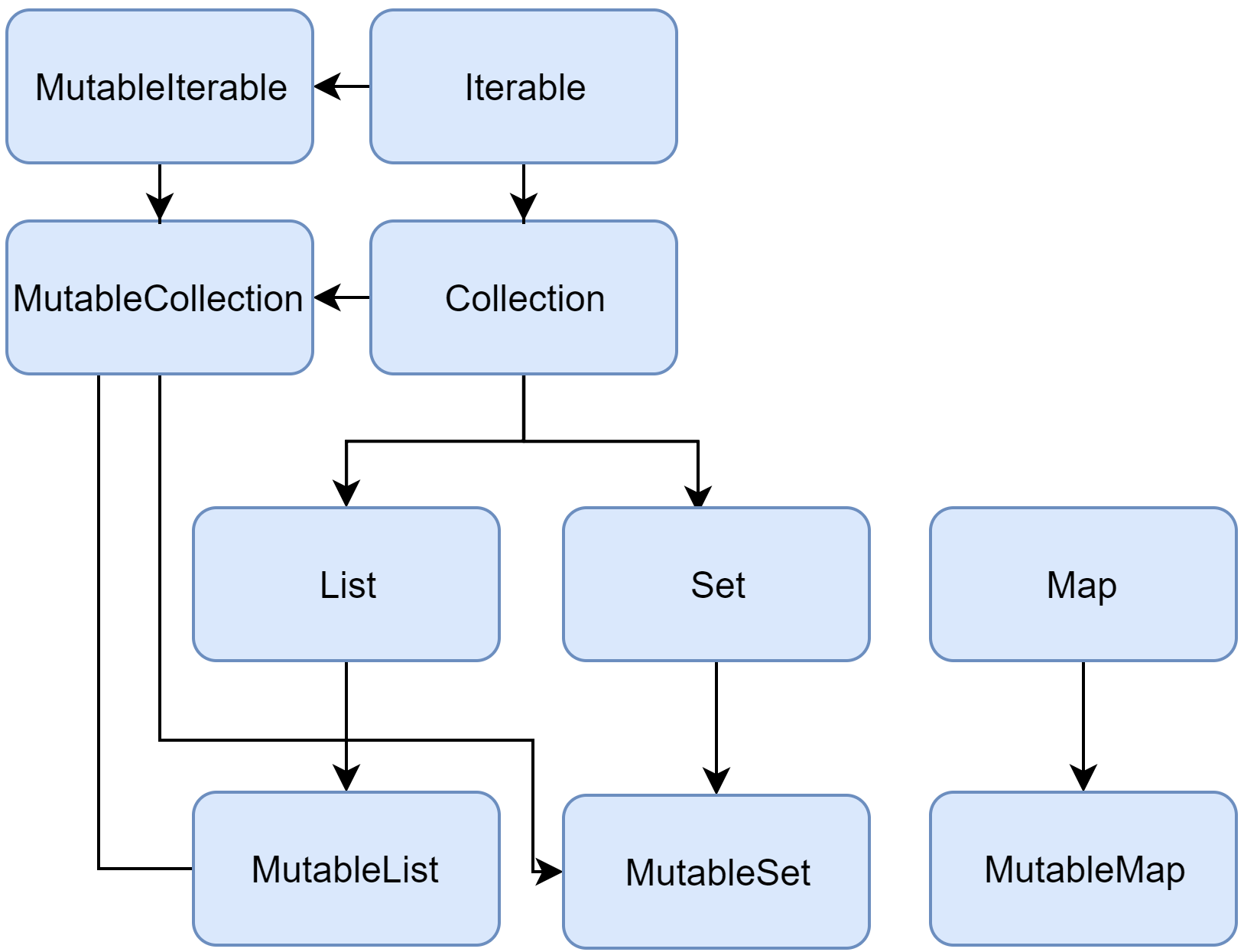集合概述
Table of Contents
Kotlin 标准库提供了一整套用于管理集合的工具,集合是可变数量(可能为零)的一组元素
各种集合对于解决问题都具有重要意义,并且经常用到,因此集合是大多数编程语言的常见概念
集合通常包含相同类型的一些(数目也可以为零)对象。集合中的对象称为元素或条目
例如,一个系的所有学生组成一个集合,可以用于计算他们的平均年龄
以下是 Kotlin 相关的集合类型:
List 是一个有序集合,可通过索引(反映元素位置的整数)访问元素。元素可以在 list 中出现多次
列表的示例是一句话:有一组字、这些字的顺序很重要并且字可以重复Set 是唯一元素的集合。它反映了集合(set)的数学抽象:一组无重复的对象
一般来说 set 中元素的顺序并不重要。例如,字母表是字母的集合(set)Map(或者字典)是一组键值对。键是唯一的,每个键都刚好映射到一个值。值可以重复
map 对于存储对象之间的逻辑连接非常有用,例如,员工的 ID 与员工的位置
Kotlin 可以独立于所存储对象的确切类型来操作集合
换句话说,将 String 添加到 String list 中的方式与添加 Int 或者用户自定义类的到相应 list 中的方式相同 因此,Kotlin 标准库为创建、填充、管理任何类型的集合提供了泛型的(通用的,双关)接口、类与函数
这些集合接口与相关函数位于 kotlin.collections 包中
集合类型
Kotlin 标准库提供了基本集合类型的实现: set 、 list 以及 map 。 每种集合类型用一对接口来表示:
- 一个 只读 接口,提供访问集合元素的 读操作
- 一个 可变 接口,通过 写操作 扩展相应的只读接口:
- 添加 元素
- 删除 元素
- 更新 元素
请注意:
更改可变集合不需要它是以 var 定义的变量
写操作修改同一个可变集合对象,因此引用不会改变- 如果尝试对 val 集合的引用重新赋值,将收到编译错误
fun main() { val numbers = mutableListOf("one", "two", "three", "four") numbers.add("five") // 这是可以的 //numbers = mutableListOf("six", "seven") // 编译错误 }
只读 集合类型是 型变 的
这意味着,如果类 Rectangle 继承自 Shape,则可以在需要 List <Shape> 的任何地方使用 List <Rectangle> 换句话说,集合类型与元素类型具有相同的子类型关系 map 在值(value)类型上是型变的,但在键(key)类型上不是
反之, 可变 集合 不是型变 的,否则将导致运行时故障
如果 MutableList <Rectangle> 是 MutableList <Shape> 的子类型,可以在其中插入其他 Shape 的继承者(例如,Circle),从而违反了它的 Rectangle 类型参数
下面是 Kotlin 集合接口的图表:

Collection
Collection<T> 是集合层次结构的根:
- 此接口表示一个 只读 集合的共同行为: 检索 大小 、检测 是否为成员 等等
- Collection 继承自 Iterable <T> 接口,它定义了 迭代 元素的操作
可以使用 Collection 作为适用于不同集合类型的函数的参数
对于更具体的情况,请使用 Collection 的继承者: List 与 Set
fun printAll(strings: Collection<String>) { for(s in strings) print("$s ") println() } fun main() { val stringList = listOf("one", "two", "one") printAll(stringList) val stringSet = setOf("one", "two", "three") printAll(stringSet) }
MutableCollection 是一个具有写操作的 Collection 接口,例如 add 以及 remove
fun List<String>.getShortWordsTo(shortWords: MutableList<String>, maxLength: Int) { this.filterTo(shortWords) { it.length <= maxLength } // throwing away the articles val articles = setOf("a", "A", "an", "An", "the", "The") shortWords -= articles } fun main() { val words = "A long time ago in a galaxy far far away".split(" ") val shortWords = mutableListOf<String>() words.getShortWordsTo(shortWords, 3) println(shortWords) }
List
List<T> 以指定的 顺序 存储元素,并提供使用 索引 访问元素的方法:
- 索引从 0 开始:第一个元素的索引
- 最后一个元素的索引 即 (list.size - 1)
fun main() { //sampleStart val numbers = listOf("one", "two", "three", "four") println("Number of elements: ${numbers.size}") println("Third element: ${numbers.get(2)}") println("Fourth element: ${numbers[3]}") println("Index of element \"two\" ${numbers.indexOf("two")}") //sampleEnd }
- List 元素(包括空值)可以重复,可以包含任意数量的相同对象或单个对象的出现
- 如果两个 List 在相同的位置具有相同大小和相同结构的元素,则认为它们是相等的
data class Person(var name: String, var age: Int) fun main() { //sampleStart val bob = Person("Bob", 31) val people = listOf<Person>(Person("Adam", 20), bob, bob) val people2 = listOf<Person>(Person("Adam", 20), Person("Bob", 31), bob) println(people == people2) bob.age = 32 println(people == people2) //sampleEnd }
MutableList 是可以进行写操作的 List,例如用于在特定位置添加或删除元素
fun main() { //sampleStart val numbers = mutableListOf(1, 2, 3, 4) numbers.add(5) numbers.removeAt(1) numbers[0] = 0 numbers.shuffle() println(numbers) //sampleEnd }
在某些方面,List 与数组(Array)非常相似。 但是,有一个重要的区别:
- 数组的大小是在初始化时定义的,永远不会改变
- List 没有预定义的大小;作为写操作的结果,可以更改 List 的大小:添加,更新或删除元素
在 Kotlin 中,List 的默认实现是 ArrayList,可以将其视为可调整大小的数组
Set
Set<T> 存储唯一的元素:
- 它们的顺序通常是未定义的
- null 元素也是唯一的:一个 Set 只能包含一个 null
- 当两个 set 具有相同的大小并且对于一个 set 中的每个元素都能在另一个 set 中存在相同元素,则两个 set 相等
fun main() { //sampleStart val numbers = setOf(1, 2, 3, 4) println("Number of elements: ${numbers.size}") if (numbers.contains(1)) println("1 is in the set") val numbersBackwards = setOf(4, 3, 2, 1) println("The sets are equal: ${numbers == numbersBackwards}") //sampleEnd }
MutableSet 是一个带有来自 MutableCollection 的写操作接口的 Set
Set的默认实现 LinkedHashSet 保留元素插入的顺序
因此,依赖于顺序的函数,例如 first() 或 last(),会在这些 set 上返回可预测的结果
fun main() { //sampleStart val numbers = setOf(1, 2, 3, 4) // LinkedHashSet is the default implementation val numbersBackwards = setOf(4, 3, 2, 1) println(numbers.first() == numbersBackwards.first()) println(numbers.first() == numbersBackwards.last()) //sampleEnd }
另一种实现方式 HashSet 不声明元素的顺序,所以在它上面调用这些函数会返回不可预测的结果
但是,HashSet 只需要较少的内存来存储相同数量的元素
Map
Map<K, V> 不是 Collection 接口的继承者,但是它也是 Kotlin 的一种集合类型
Map 存储 键/值 对:
- 键是唯一的,但是不同的键可以与相同的值配对
- Map 接口提供特定的函数进行通过键访问值、搜索键和值等操作
fun main() { val numbersMap = mapOf("key1" to 1, "key2" to 2, "key3" to 3, "key4" to 1) println("All keys: ${numbersMap.keys}") println("All values: ${numbersMap.values}") if ("key2" in numbersMap) println("Value by key \"key2\": ${numbersMap["key2"]}") if (1 in numbersMap.values) println("The value 1 is in the map") if (numbersMap.containsValue(1)) println("The value 1 is in the map") }
无论键值对的顺序如何,包含相同键值对的两个 Map 是相等的
fun main() { //sampleStart val numbersMap = mapOf("key1" to 1, "key2" to 2, "key3" to 3, "key4" to 1) val anotherMap = mapOf("key2" to 2, "key1" to 1, "key4" to 1, "key3" to 3) println("The maps are equal: ${numbersMap == anotherMap}") //sampleEnd }
MutableMap 是一个具有写操作的 Map 接口,可以使用该接口添加一个新的键值对或更新给定键的值
fun main() { //sampleStart val numbersMap = mutableMapOf("one" to 1, "two" to 2) numbersMap.put("three", 3) numbersMap["one"] = 11 println(numbersMap) //sampleEnd }
| Next:构造 | Home:集合 |